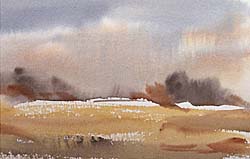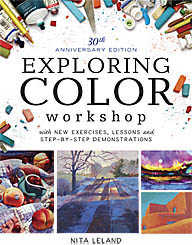Limited palette watercolor

I can always count on the Monday watercolor class to raise my spirits. They have such a high level of enthusiasm and they've almost completely eliminated "can't" from their vocabularies. Today I gave them a big surprise. Many of them started with my beginning class, where we used Payne's Gray to do value studies as a means of learning brushstrokes and washes. Then I forbade them to use it when we learned split-primary color mixing, because it muddies color pretty quickly if you don't know how to use it. They laugh at me when I screech at the sight of Payne's Gray on their palettes or in their paintings. So today I did a little demo and showed them how to use PG as a color in the Old Master's Palette of Burnt Sienna, Raw Sienna (or Yellow Ochre) and Payne's Gray. PG is very beautiful when it's integrated into a harmonious palette of earth hues. Several of them tried it and got beautiful results. Next week we're going to plan our exhibition, which is opening October 16.
Labels: color mixing, palette, tutorials, value, watercolor





5 Comments:
I had forgotten how beautiful that palette could be. My first w/c teacher had us use it a few times and we were all pleasantly surprised at the results. I think I will try using it again.
Michelle
Just don't forget that Payne's Gray dries up to fifty per cent lighter than most watercolors. It can fade back in a flash, so you need to push it with the first brush stroke, especially if you're working wet-into-wet.
Creativity does crackle sometimes and other times it just flows. It's a wonderful experience, either way.
Nita, I have been using your triads for some time now and thus have begun to change the looks of my paintings. Working hard to get that colour you want is an exciting journey!
Joyce--It's nice to get this kind of feedback. You're right--it's an exciting journey.
Post a Comment
<< Home